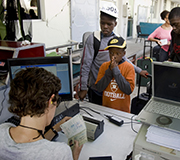
Understanding large movements of refugees and migrants
The world is currently experiencing one of the highest number of migrants and refugees ever recorded, some searching for better economic opportunities, others seeking safety from conflict and crises. On 25 April, UN DESA, together with the United Nations High Commissioner for Refugees (UNHCR) and the International Organization for Migration (IOM), organized an interactive, multi-stakeholder meeting on “Understanding large movements of refugees and migrants”.
The meeting, which was co-chaired by the permanent missions of the Kingdom of the Netherlands and the Kingdom of Thailand, kicked off a series of substantive meetings, organized under the auspices of the Global Migration Group (GMG), which will assist representatives from Member States, international organizations, and civil society to prepare for the General Assembly High-level Plenary Meeting on addressing large movements of refugees and migrants on 19 September 2016.
The first meeting provided an overview of the magnitude, drivers and impact of large movements of refugees and migrants.
The opening panel featured brief statements by the Deputy Executive Director of UN Women, as 2016 Chair of the GMG, and the permanent representatives of the Netherlands and Thailand. The co-chairs of the meeting expressed their gratitude to the GMG and in particular to UN DESA, UNHCR and IOM for organizing this timely and useful substantive meeting leading up to 19 September.
In the first panel, UN DESA provided an overview of global levels and trends in international migration and refugee movements, discussed the role of population dynamics as a driver for migration, and presented global indicators for sharing responsibility in hosting refugees.
The panel also featured presentations from UNHCR, IOM, a researcher and a representative from civil society providing insights into the global refugee situation, the causes of displacement and the lack of lasting solutions for refugees. The speakers also underscored importance of the 2030 Agenda for Sustainable Development in addressing large movements of refugees and migrants and discussed the role of environmental factors and climate change in migration and displacement.
The s econd panel featuring speakers from the World Bank, the United Nations Development Programme, the International Fund for Agricultural Development and civil society, who focused on the impact of, and responses to, large movements of refugees and migrants.
econd panel featuring speakers from the World Bank, the United Nations Development Programme, the International Fund for Agricultural Development and civil society, who focused on the impact of, and responses to, large movements of refugees and migrants.
The panelists discussed the integration of migrants and refugees in national development planning and highlighted the contribution of migrants and refugees to countries of origin, transit and destination, including through remittance transfers. They also discussed the challenges of mass population flows for women and children.
The meeting, attended by over 120 representatives from Member States, the UN system and civil society, provided ample space for interaction between the panelists and the audience. The level of participation and interaction indicated the significant interest of the international community in the preparations for the General Assembly Meeting on 19 September.

Follow Us